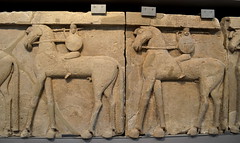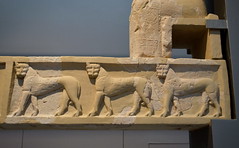
Limestone reliefs of panthers and sculptures of seated females wearing poloi, possibly forming the lintel of Building ('Temple') A at Prinias. Near Eastern and Egyptian stylistic influences can be discerned in the work.
Archaic period, 7th c. BCE.
Prinias, Crete, possibly ancient Ῥιζενία (Rhizenia), though the identification is not certain.
(Pleiades; Wikipedia; Perseus; Treccani; SAIA)
The ancient site at Prinias is situated in central Crete, controlling the passes between the area of Knossos to the north and the Mesara and Gortyn to the south. The settlement lies on a triangular plateau called the Patela, 680 masl, with steep, impassable cliffs on all sides. Access is from the west. Substantial occupation at Prinias begins at the end of the Bronze Age, in the Late Minoan IIIC period. Habitation on the plateau continued into the 9th century BCE, although it is difficult to associate much architecture with this phase. Changes in the settlement toward the end of the 8th century include the construction of well-planned house-blocks with well laid out streets, open spaces, and possibly cult buildings. Most of the excavated architecture dates to this period, between the 8th and 6th centuries BCE. The site is known for its early monumental architecture, in the form of Buildings (or 'Temples') A and B. The settlement was destroyed or abandoned sometime in the middle of the 6th century BCE, since the latest datable pottery is early Middle Corinthian; the final burials in the necropolis also date to the mid 6th century.
Beyer, Immo. 1976. Die Tempel von Dreros und Prinias A und die Chronologie der kretischen Kunst des 8. und 7. Jhs. v. Chr. Berlin: Wasmuth.
Rizza, Giovanni, ed. 2008. Priniàs: la città arcaica sulla Patela: scavi condotti negli anni 1969-2000. Rome: Consiglio Nazionale delle Ricerche.
———. 2011. Identità culturale, etnicità, processi di trasformazione a Creta fra Dark Age e Arcaismo: per i cento anni dello scavo di Priniàs 1906-2006 (convegno di studi, Atene 9-12 novembre 2006). Catania.


















